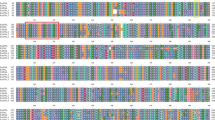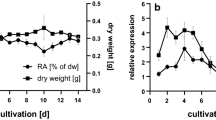Abstract
Lemon balm (Melissa officinalis, Lamiaceae) is a well-known medicinal plant. Amongst the biologically active ingredients are a number of phenolic compounds, the most prominent of which is rosmarinic acid. To obtain better knowledge of the biosynthesis of these phenolic compounds, two enzymes of the general phenylpropanoid pathway, phenylalanine ammonia-lyase (PAL) and 4-coumarate:coenzyme A-ligase (4CL), were investigated in suspension cultures of lemon balm. MoPAL1 and Mo4CL1 cDNAs were cloned and heterologously expressed in Escherichia coli and the enzymes characterised. Expression analysis of both genes showed a correlation with the enzyme activities and rosmarinic acid content during a cultivation period of the suspension culture. Southern-blot analysis suggested the presence of most probably two gene copies in the M. officinalis genome of both PAL and 4CL. The genomic DNA sequences of MoPAL1 and Mo4CL1 were amplified and sequenced. MoPAL1 contains one phase 2 intron of 836 bp at a conserved site, whilst Mo4CL1 was devoid of introns.




Similar content being viewed by others
Abbreviations
- 4CL:
-
4-Coumarate:CoA ligase
- C4H:
-
Cinnamic acid 4-hydroxylase
- CoA:
-
Coenzyme A
- CSPD:
-
Disodium 3-(4-methoxyspiro{l,2-dioxetane-3,2′-(5′-chloro)tricyclo[3.3.1.13,7]decan}-4-yl) phenylphosphate
- DTT:
-
Dithiothreitol
- DW:
-
Dry weight
- Orf:
-
Open reading frame
- PAL:
-
Phenylalanine ammonia-lyase
- RA:
-
Rosmarinic acid
- SSC:
-
Saline sodium citrate buffer
References
Becker-André M, Schulze-Lefert P, Hahlbrock K (1991) Structural comparison, modes of expression, and putative cis-acting elements of the two 4-coumarate:CoA ligase genes in potato. J Biol Chem 266:8551–8559
Berger A, Meinhard J, Petersen M (2006) Rosmarinic acid synthase is a new member of the superfamily of BAHD acyltransferases. Planta 224:1503–1510
Bradford MM (1976) A rapid and sensitive method for the quantitation of microgram quantities of protein utilizing the principle of protein-dye binding. Anal Biochem 72:248–254
Carnat AP, Carnat A, Fraisse D, Lamaison JL (1998) The aromatic and polyphenolic composition of lemon balm (Melissa officinalis L. subsp. officinalis) tea. Pharm Acta Helv 72:301–305
Chang A, Lim MH, Lee SW, Robb EJ, Nazar RN (2008) Tomato phenylalanine ammonia-lyase gene family, highly redundant but strongly underutilized. J Biol Chem 283:33591–33601
Chomczynski P, Sacchi N (1987) Single-step method of RNA isolation by acid guanidinium thiocyanate–phenol–chloroform extraction. Anal Biochem 162:156–159
Cochrane FC, Davin LB, Lewis NG (2004) The Arabidopsis phenylalanine ammonia lyase gene family: kinetic characterization of the four PAL isoforms. Phytochemistry 65:1557–1564
Cramer CL, Edwards K, Dron M, Liang X, Dildine SL, Bolwell GP, Dixon RA, Lamb CJ, Schuch W (1989) Phenylalanine ammonia-lyase gene organization and structure. Plant Mol Biol 12:367–383
Cukovic D, Ehlting J, VanZiffle JA, Douglas CJ (2001) Structure and evolution of 4-coumarate:coenzyme A ligase (4CL) gene families. Biol Chem 382:645–654
De Eknamkul W, Ellis BE (1987) Tyrosine aminotransferase: the entry-point enzyme of the tyrosine-derived pathway in rosmarinic acid biosynthesis. Phytochemistry 26:1941–1946
Dixon RA, Paiva NL (1995) Stress-induced phenylpropanoid metabolism. Plant Cell 7:1085–1097
Eberle D, Ullmann P, Werck-Reichhart D, Petersen M (2009) cDNA cloning and functional characterisation of CYP98A14 and NADPH:cytochrome P450 reductase from Coleus blumei involved in rosmarinic acid biosynthesis. Plant Mol Biol 69:239–253
Ehlting J, Büttner D, Wang Q, Douglas CJ, Somssich IE, Kombrink E (1999) Three 4-coumarate:coenzyme A ligases in Arabidopsis thaliana represent two evolutionary divergent classes in angiosperms. Plant J 19:9–20
Ehlting J, Shin JJK, Douglas CJ (2001) Identification of 4-coumarate:coenzyme A ligase (4CL) substrate recognition domains. Plant J 27:455–465
Ellis BE, Towers GHN (1970) Biogenesis of rosmarinic acid in Mentha. Biochem J 118:291–297
Engler-Blum G, Meier M, Frank J, Müller GA (1993) Reduction of background problems in nonradioactive Northern and Southern blot analyses enables higher sensitivity than 32P-based hybridizations. Anal Biochem 210:235–244
Fecka I, Turek S (2007) Determination of water-soluble polyphenolic compounds in commercial herbal teas from Lamiaceae: peppermint, Melissa, and sage. J Agric Food Chem 55:10908–10917
Gang DR, Simon J, Lewinsohn E, Pichersky E (2002) Peltate glandular trichomes of Ocimum basilicum L. (Sweet Basil) contain high levels of enzymes involved in the biosynthesis of phenylpropenes. J Herbs Spices Med Plants 9:189–195
Hahlbrock K, Scheel D (1989) Physiology and molecular biology of phenylpropanoid metabolism. Annu Rev Plant Physiol Plant Mol Biol 40:347–369
Häusler E, Petersen M, Alfermann AW (1991) Hydroxyphenylpyruvate reductase from cell suspension cultures of Coleus blumei Benth. Z Naturforsch 46c:371–376
Heitz A, Carnat A, Fraisse D, Carnat AP, Lamaison JL (2000) Luteolin 3′-glucuronide, the major flavonoid from Melissa officinalis subsp. officinalis. Fitotherapia 71:201–202
Huang B, Yi B, Duan Y, Sun L, Yu X, Guo J, Chen W (2008) Characterization and expression profiling of tyrosine aminotransferase gene from Salvia miltiorrhiza (Dan-shen) in rosmarinic acid biosynthesis pathway. Mol Biol Rep 35:601–612
Joos HJ, Hahlbrock K (1992) Phenylalanine ammonia-lyase in potato (Solanum tuberosum L.). Eur J Biochem 204:621–629
Kim KH, Janiak V, Petersen M (2004) Purification, cloning and functional expression of hydroxyphenylpyruvate reductase involved in rosmarinic acid biosynthesis in cell cultures of Coleus blumei. Plant Mol Biol 54:311–323
Kumar A, Ellis BE (2001) The phenylalanine ammonia-lyase gene family in raspberry: structure, expression, and evolution. Plant Physiol 127:230–239
Kumar A, Ellis BE (2003) 4-Coumarate:CoA ligase gene family in Rubus idaeus: cDNA structures, evolution, and expression. Plant Mol Biol 31:327–340
Lee SW, Robb J, Nazar RN (1992) Truncated phenylalanine ammonia-lyase expression in tomato (Lycopersicon esculentum). J Biol Chem 267:11824–11830
Lindermayr C, Möllers B, Fliegmann J, Uhlmann A, Lottspeich F, Meimberg H, Ebel J (2002) Divergent members of a soybean (Glycine max L.) 4-coumarate:coenzyme A ligase gene family. Eur J Biochem 269:1304–1315
Lozoya E, Hoffmann H, Douglas C, Schulz W, Scheel D, Hahlbrock K (1988) Primary structures and catalytic properties of isoenzymes encoded by the two 4-coumarate:CoA ligase genes in parsley. Eur J Biochem 176:661–667
Mahesh V, Rakotomalala JJ, Gal LL, Vigne H, de Kochko A, Hamon S, Noirot M, Campa C (2006) Isolation and genetic mapping of a Coffea canephora phenylalanine ammonia-lyase gene (CcPAL1) and its involvement in the accumulation of caffeoyl quinic acids. Plant Cell Rep 25:986–992
Matsumoto S, Takeuchi A, Hayatsu M, Kondo S (1994) Molecular cloning of phenylalanine ammonia-lyase cDNA and classification of varieties and cultivars of tea plants (Camellia sinensis) using the tea PAL cDNA probe. Theor Appl Genet 89:671–675
Matsuno M, Nagatsu A, Ogihara Y, Ellis BE, Mizukami H (2002) CYP98A6 from Lithospermum erythrorhizon encodes 4-coumaroyl-4′-hydroxyphenyllactic acid 3-hydroxylase involved in rosmarinic acid biosynthesis. FEBS Lett 514:219–224
Mazzanti G, Battinelli L, Pompeo C, Serrilli AM, Rossi R, Sauzullo I, Mengoni F, Vullo V (2008) Inhibitory activity of Melissa officinalis L. extract on Herpes simplex virus type 2 replication. Nat Prod Res 23:1433–1440
Mulkens A, Kapetanidis I (1987) Flavonoids from leaves of Melissa officinalis L. (Lamiaceae). Pharm Acta Helv 62:19–22
Murin A (1997) Karyotaxonomy of some medicinal and aromatic plants. Thaiszia 7:75–88
Parnham MJ, Kesselring K (1985) Rosmarinic acid. Drugs Future 10:756–757
Patora J, Klimek B (2002) Flavonoids from lemon balm (Melissa officinalis L., Lamiaceae). Acta Pol Pharm 59:139–143
Petersen M (1991) Characterization of rosmarinic acid synthase from cell cultures of Coleus blumei. Phytochemistry 30:2877–2881
Petersen M (1994) Coleus spp.: in vitro culture and the production of forskolin and rosmarinic acid. In: Bajaj YPS (ed) Biotechnology in agriculture and forestry, medicinal and aromatic plants VI. Springer, Berlin, pp 69–92
Petersen M (1997) Cytochrome P-450-dependent hydroxylation in the biosynthesis of rosmarinic acid in Coleus. Phytochemistry 45:1165–1172
Petersen M, Alfermann AW (1988) Two new enzymes of rosmarinic acid biosynthesis from cell cultures of Coleus blumei: hydroxyphenylpyruvate reductase and rosmarinic acid synthase. Z Naturforsch 43c:501–504
Petersen M, Simmonds MSJ (2003) Molecules of interest: rosmarinic acid. Phytochemistry 62:121–125
Petersen M, Häusler E, Karwatzki B, Meinhard J (1993) Proposed biosynthetic pathway for rosmarinic acid in cell cultures of Coleus blumei Benth. Planta 189:10–14
Petersen M, Abdullah Y, Benner J, Eberle D, Gehlen K, Hücherig S, Janiak V, Kim KH, Sander M, Weitzel C, Wolters S (2009) Evolution of rosmarinic acid biosynthesis. Phytochemistry 70:1663–1679
Ritter H, Schulz GE (2004) Structural basis for the entrance into the phenylpropanoid metabolism catalyzed by phenylalanine ammonia-lyase. Plant Cell 16:3426–3436
Rogers SO, Bendich AJ (1985) Extraction of DNA from milligram amounts of fresh, herbarium and mummified tissues. Plant Mol Biol 5:69–76
Scarpati ML, Oriente G (1958) Isolamento e costituzione dell’acido rosmarinico (dal rosmarinus off.). Ric Sci 28:2329–2333
Schneider K, Hövel K, Witzel K, Hamberger B, Schomburg D, Kombrink E, Stuible HP (2003) The substrate specificity-determining amino acid code of 4-coumarate:CoA ligase. Proc Natl Acad Sci USA 100:8601–8606
Song J, Wang Z (2009) Molecular cloning, expression and characterization of a phenylalanine ammonia-lyase gene (SmPAL1) from Salvia miltiorrhiza. Mol Biol Rep 36:939–952
Strid A (1983) IOPB chromosome number reports LXXVIII. Taxon 32:138–140
Stuible HP, Büttner D, Ehlting J, Hahlbrock K, Kombrink E (2000) Mutational analysis of 4-coumarate:CoA ligase identifies functionally important amino acids and verifies its close relationship to other adenylate-forming enzymes. FEBS Lett 467:117–122
Szabo E, Thelen A, Petersen M (1999) Fungal elicitor preparations and methyl jasmonate enhance rosmarinic acid accumulation in in vitro-cultures of Coleus blumei. Plant Cell Rep 18:485–489
Tamura K, Dudley J, Nei M, Kumar S (2007) MEGA4: molecular evolutionary genetics analysis (MEGA) software version 4.0. Mol Biol Evol 24:1596–1599
Wanner LA, Li G, Ware D, Somssich IE, Davis KR (1995) The phenylalanine ammonia-lyase gene family in Arabidopsis thaliana. Plant Mol Biol 27:327–338
Wölbling RH, Leonhardt K (1994) Local therapy of herpes simplex with dried extracts from Melissa officinalis. Phytomedicine 1:25–31
Xu F, Cai R, Cheng S, Du H, Wang Y, Cheng S (2008) Molecular cloning, characterization and expression of phenylalanine ammonia-lyase gene from Ginkgo biloba. Afr J Biotechnol 7:721–729
Yazaki K, Ogawa A, Tabata M (1995) Isolation and characterization of two cDNAs encoding 4-coumarate:CoA ligase in Lithospermum cell cultures. Plant Cell Physiol 36:1319–1329
Yazaki K, Kataoka M, Honda G, Severin K, Heide L (1997) cDNA cloning and gene expression of phenylalanine ammonia-lyase in Lithospermum erythrorhizon. Biosci Biotechnol Biochem 61:1995–2003
Zhang XH, Chiang VL (1997) Molecular cloning of 4-coumarate:coenzyme A ligase in loblolly pine and the roles of this enzyme in the biosynthesis of lignin in compression wood. Plant Physiol 113:65–74
Zhao SJ, Hu ZB, Liu D, Leung FCC (2006) Two divergent members of 4-coumarate:coenzyme A ligase from Salvia miltiorrhiza Bunge: cDNA cloning and functional study. J Integr Plant Biol 48:1355–1364
Author information
Authors and Affiliations
Corresponding author
Electronic supplementary material
Below is the link to the electronic supplementary material.
Rights and permissions
About this article
Cite this article
Weitzel, C., Petersen, M. Enzymes of phenylpropanoid metabolism in the important medicinal plant Melissa officinalis L.. Planta 232, 731–742 (2010). https://doi.org/10.1007/s00425-010-1206-x
Received:
Accepted:
Published:
Issue Date:
DOI: https://doi.org/10.1007/s00425-010-1206-x




